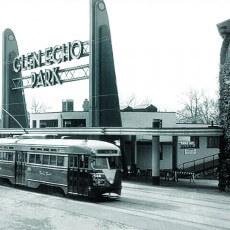- October 10, 2017
- By Liam Farrell
Nestled between suburbia and the C&O Canal, Glen Echo Park appears out of wooded paths like a fairy tale setting, with playful 1970s yurts, a gorgeously restored 1920s carousel and the Art Deco facades of a long-closed amusement park still advertising popcorn, a teacup ride and swimming pool. You almost expect Rapunzel’s hair to come flowing down from the 19th-century stone tower at its gate.
Park officials hope to build on this whimsical foundation and expand Glen Echo’s impact as a regional arts center, and they recently turned to UMD for help in kick-starting a new master plan. A graduate architecture class in the spring tackled needs such as additional facilities for arts programs, environmental sustainability, stormwater management and visitor wayfinding as it came up with proposals to revitalize the park.
“Students are really good at innovative thinking to imagine multiple possible futures,” says Madlen Simon, the associate professor of architecture who taught the course. “There’s an aspect of wonder about this place that inspires the imagination.”

Founded as an arts and education facility in 1891, nine-acre Glen Echo Park was once an immensely popular amusement park; each summer day, thousands of visitors drove from Maryland and Virginia or traveled up from D.C. via streetcar to ride the Coaster Dips, swim in the Crystal Pool or dance in the Spanish Ballroom. The main attraction, still standing, was the hand-carved animals of the Dentzel Carousel. In 1960, civil rights activists climbed aboard that ride to protest the park’s segregation, and ensuing protests led to integration the next year.
The amusement park closed in 1968, and the National Park Service took over in 1971. Today, in collaboration with Montgomery County and the nonprofit Glen Echo Partnership for Arts and Culture, the park has circled back to its roots, housing arts organizations, children’s theaters, galleries and dance, nature and arts programs that draw 350,000 visitors a year.
Some renovations were done from 2003-10, but Katey Boerner, the park’s executive director, says there still isn’t adequate gallery and studio space and the park could be improved to function at the highest environmental standards.
“There are missing pieces if you want a full-service arts center,” she says. “We have a lot of great ideas and needs, but we don’t know a lot about facility and site planning.”
Students visited the property and interviewed park patrons and leaders to brainstorm. Split into three teams, they presented proposals to the park’s master planning committee, and suggested adding a welcome center, incorporating green roofs, creating a market street for artists to sell crafts, and even making a looping elevated walkway that mimics the path of the historic roller coaster.
“It’s an incredibly challenging site,” says graduate student Peter Cunningham. “It’s really inspiring to think that the work I do now, even though I’m a student, has significance.”
Although the planning process is just under way, Christopher Fromboluti, a park board member, predicts that UMD will imprint the final product.
“They did a great job in getting it going,” he says. “We have got a lot to talk about.”
